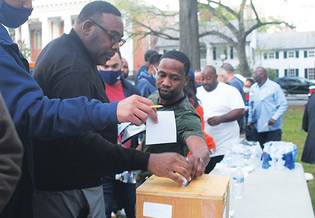
Thomas Breen/New Haven Independent
Members of Local 35, including vice president Brian Wingate (left) voted on a new contract with Yale on the Green on October 20.
View full image
In late September, after 16 months of negotiations on Zoom and demonstrations in the streets, Yale’s two largest unions, Locals 34 and 35 of UNITE-HERE, agreed to terms for a new five-year contract and arrived at a tentative peace with the university. The city’s labor-dominated Board of Alders had been ramping up the pressure, voting to close Prospect Street to traffic for a day to let union members, local activists, and students retouch a protest mural that had been painted on the asphalt back in May—the bold white letters between the cemetery and Becton Center that read, “Yale: Respect New Haven.” And in the background of it all was the clock—a January 1, 2022 deadline that, if missed, might have triggered the unions’ first walkout since 2003.
Disputes between Yale and the unions come around between every two and eight years, but for the most part every five, and they typically take the same shape. The unions frame them around ethics, a choice between basic loyalty and brutal austerity; the university frames them around economics—the contingency of its finances and the need for compromise. Toward the beginning of this round, in large part thanks to the pandemic, the tone was even more existential. “Yale has a choice to make,” wrote Barbara Vereen, organizing director of Local 34, the university’s clerical and technical union, in a July 2020 op-ed in the New Haven Register. “They can try to use a historic public health and economic crisis to extract even more from those who have so little. Or they can step up for a better future for us all.”
The university was cautious at the outset. “We didn’t know what was going on with the financial outlook of the university,” says Jack F. Callahan Jr. ’80, Yale’s senior vice president for operations. He sits on the Policy Board, a committee of senior officials in the administration and leaders from the unions that negotiates the university’s labor contracts. “We had no idea how the pandemic was going to hit us, the stock market was incredibly volatile, the endowment was going down. Now, as it turns out, it worked out. Our revenues held up better than we thought, and the endowment did extremely well. So as we went through this on the university’s side, we also realized that we could make broader financial choices than we thought we could going into it.”
By the fall, each side had settled in, and the terms of the new contract were starting to crystallize. The final September agreement, among other things, expands retirement income benefits; includes no-layoff and one-for-one hiring clauses; provides options for remote work; raises hourly wages for members of 34 by an average of $3.07 over five years; and raises 35’s by an average of $4.14 (13 percent across the board). It also commits to a kind of future-proofing jobs guarantee to prevent layoffs in the face of new automation: what Jane Savage, Yale’s associate vice president of union-management and strategic initiatives, calls “an alternate placement process when jobs are displaced to provide employment security in the face of the pandemic recovery and technological change.”
On a warm October night, hundreds of members of Local 35 gathered on the New Haven Green to vote on these terms, and ratified them overwhelmingly. About two miles to the west, on a lawn near the Yale Bowl, many of 34’s 3,700 members met to do the same. Music blared and hundreds of cars pulled in to get a view of the stage. When all the votes had been counted, the crowd cheered and honked horns. There was something to celebrate.
 loading
loading